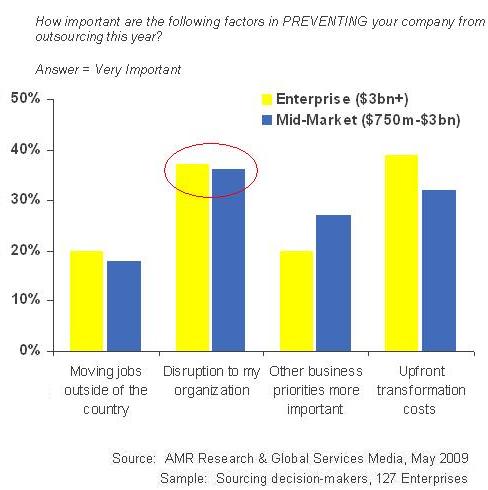 2009 is going to be remembered as the year of cost-containment. Most client discussions are not very sexy – it’s largely about cost, as opposed to innovation or revenue generation. McKinsey recently revealed 70% of its current client engagements are cost-reduction focused, only 30%focused on revenue-generation (the opposite of a year ago).
2009 is going to be remembered as the year of cost-containment. Most client discussions are not very sexy – it’s largely about cost, as opposed to innovation or revenue generation. McKinsey recently revealed 70% of its current client engagements are cost-reduction focused, only 30%focused on revenue-generation (the opposite of a year ago).
I strongly believe our businesses, while being diligent about cost-containment, must use this opportunity to make fundamental changes to their business operations in order to emerge more profitably in the future. Simply ripping away cost elements and failing to improve access to global corporate data and processes, is a massive wasted opportunity to be more competitive over the long-term.
I wrote recently about how the lay-off culture that has afflicted both the US and UK in recent years, where many firms treat their labor as a variable cost that can be scaled-up or down at will, depending on the next quarterly forecast. I cannot stress enough the damage this can cause to businesses as the economy recovers. One common theme that has dominated discussions with business leaders recently has been their surprise at the amount of visible cost they have been able to take out of their businesses as they move from a revenue-generation to cost-containment strategy.
It’s not solely the cost of labor that is highly visible – it’s the costs of technology, travel, infrastructure, real-estate etc. that can often be easily driven-down in a desperate business climate. Less visible are costs associated with poorly-integrated business processes and procedures, of dated analytical tools, of ERP systems incapable of supporting global process templates, and so on.
Focusing too heavily on labor take-out polarizes a corporate culture on visible short-term quick-hits as opposed longer-term innovative strategies that will ultimately help the company become more productive and profitable. Doing things the same way as before, but with less resources, is a slippery-slope to corporate failure in this environment. The same slippery-slope scenario applies to outsourcing, where companies fail to drive any business transformation, and simply focus on the quick-hit of using low-cost labor.
And whether or not a firm outsources IT or business processes, its operations leaders should be examining how to make these processes more efficient, and how they can span global business units more effectively. This short-termism causes a general stagnation where anything that causes change to peoples' roles and responsibilities scares them. Our recent survey shows “business disruption” as a major impediment to outsourcing. I read this as “fear of change”:
Fear of disruption holding back outsourcing

Outsourcing in a tough market is a powerful lever to drive business transformation, improve workflows and associated technology, provided it is managed with process innovation as the ultimate goal. Yes, it often involves some layoffs, but never as many as when companies go through downsizing exercises with no other goal in mind other than cost-reduction.
Operations executives are capable of driving change into their processes, their technologies, their own roles and their employees' roles, but many of them are simply not incentivized to flirt with change. They are so scared of what change means to their job security, they opt for more of the same, normally with less resources or staff to do it.
Ultimately, if companies fail to shed this stagnation mentality, they will become increasingly uncompetitive globally, if their competitors embrace global sourcing models to drive out excessive cost and improve their global business operations.
So what do we take from all this? Simply put, short-termism drives negative and anti-innovative corporate behavior. Business leaders need to find ways to develop their management talent more effectively to cope with change and disruption.
Posted in : Business Process Outsourcing (BPO), Cloud Computing, IT Outsourcing / IT Services, SaaS, PaaS, IaaS and BPaaS, Sourcing Best Practises







Your articles get better and better. You really strike a chord here Phil. Stagnation is a huge issue for many companies right now.
Bryan Jones
Those business that stagnate will die in this economy. Outsourcing can act as a change agent, but ultimately it’s the will to embrace change and try out new ways of driving our cost while transforming processes.
I likewise concur. We have striped our companies of capitalization through the removal of earnings aire marked for shareholder satisfaction. As a result we are forced into a cost reduction mentality to further meet earnings goals. But as you point out there has to been an end or at least a innovation transformation. The rub is that innovation is not something that you train into an organization, it has to exist in both culture and in the talent pool. Unfortunately that pool may not be housed outside the organization as a result of staffing cutbacks. We are apt to see new startups but given the funding shortages may not see the rally that we would have expected in better times.
I find in the economy one of the biggest dangers to businesses is losing a great deal of their market share. In these tough times many business owners look at their expenses and decide to cut their marketing budget! This is defiantly the wrong thing to do since right now is the biggest oppurtunity in the marketing world.
With hundreds of companies in every industry scaling back their marketing budget there is a huge potential to gain a larger share of the market in these tough times. If you were to increase your marketing and advertising you would be able to effectively gain considerable market share. In the same effect people still have needs and wants during a recession and money is still being spent.
After the recession is over and everything is on the up and up again you will be able to retain your market share and grow considerably. This is the time to push hard! If you push now, you are setting your company up for success in the future!
I think letting panic override judgment is the worst possible danger to businesses. They see their profits or market share drop or their stock price drop, their shareholders yelp, and they freak out. After they do the sensible things in terms of cutting costs and trying to increase productivity and rebuild their bottom line, instead of saying “well, it’s a downturn, it’s awful, we have to ride this out and we’ve made XYZ preparations,” they turn to the stupid side of the force.
They forget infrastructure maintenance, which will cost them down the road.
They close plants (incurring costs that may be greater than those of repair).
They don’t just lay off, they decimate, causing more personnel writedowns, impairing the economy as a whole, and doing lousy things for their image, for worker morale, and loyalty (what’s that?).
They forget about R&D. They slash marketing (which isn’t very forward-looking), and they bring in overpriced consultants.
Sometimes, the best thing to do is hunker down and ride out the storm.
Susan Shwartz
Frankly I think the biggest danger to small business is being squashed like a bug by the enormous conglomerates that are being bailed out by government.
Herb
I think we all are guilty of spending too much time looking at the bottom line from a cost perspective.
The reality is that great companies that survive and thrive do so by continuously reinventing themselves and growing top line growth whilst managing their cost base effectively.
Sourcing should be about making the organisation easier to do business with, increasing flexibility in the delivery model and reducing the cost to serve.
We should never lose sight of the fact that taking 20% out of a 5% cost base by sourcing is incredibly inefficient, from a money and human capital perspective, when compared to growing your revenues by 5% to 10%. Overly simplistic but I think you get my drift.
No doubt, “disruption” is here to stay, whether one is talking about Outsourcing certain business processes, breaking out of an organization’s out-dated view of the competitive landscape or the rise of women to leadership roles. If someone needs ammo about the importance of disruption to business, I recommend they avail themselves of Tom Peter’s thoughts at http://www.tompeters.com
Corey